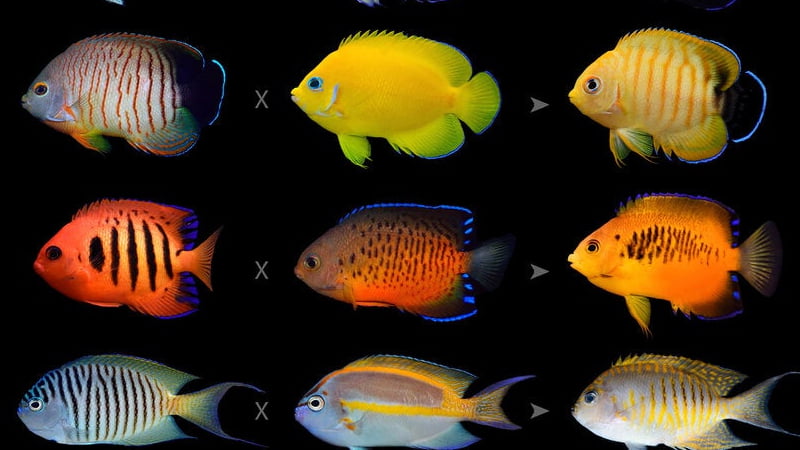If you want to fill your aquarium with fish that are attractive, full of life, and always moving, dwarf angelfish are some of the best options. However, not all angelfish can be kept in reef environments or in tanks with other saltwater fish.
Therefore, the question is what dwarf angelfish are reef safe. In this article, we will answer this question for you by listing out the top 7 best dwarf angelfish for reef tanks.
Related Articles:
- Coral Beauty Angelfish Best Profile: Habitat, Size, Behavior, Lifespan, Diet, Breeding & More
- Where To Buy Altum Angelfish? 3 Big Risks You Have To Face
- Altum Angelfish Care Guide: Lifespan, Size, Tank Size & Setup, Water Parameters, Breeding & More
- 2 Characteristics About Black Angelfish That You May Not Know
Are Dwarf Angelfish Reef Safe?
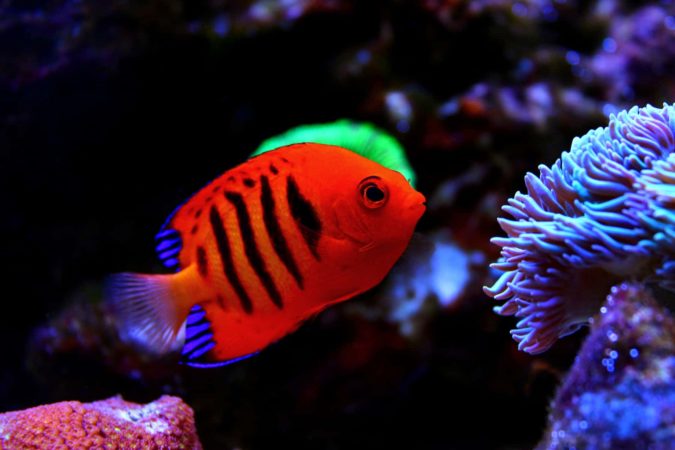
In general, Dwarf Angels need a tank with a minimum capacity of 55 gallons and lots of places to hide. More than one dwarf angel may be maintained in tanks larger than 75 gallons, but in smaller tanks, it’s better to limit it to one every 50 gallons. It has been observed that some Dwarf Angels nibble on the surface of corals, whereas others are less prone to do so if they are well fed.
It would seem that some of these fish have distinctive behaviors that correspond to their individual personalities. Even within the same species of dwarf angels, there are individuals that are harmless to the coral while others are harmful. Generally speaking, some species are more likely to cause coral damage than others.
Top 7 Best Dwarf Angelfish For Reef Tank
The following is a list of the more frequent dwarf angels that have a tendency to nibble on coral, ranked from least likely, likely, to most likely.
Coral Beauty – least likely
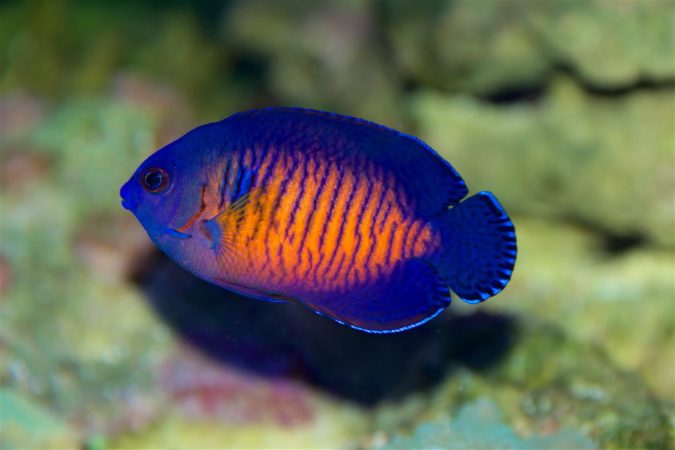
+ Description
Colorful and hardy, the Coral Beauty is a favorite saltwater angelfish among hobbyists. The color of the fish’s body, tail, edges, and fins may vary depending on the species’ native environment, but most have orange, red, or yellow bodies with purple or deeper blue fins, edges, and tails.
+ Reef- compatibility cautions
As a result of Coral Beauty’s various nutritional needs, clams and soft fleshy coral have been spotted being consumed. Although this is a one-off incident, it is not the norm. Feeding the fish a variety of foods regularly is the best approach to keep it away from softies and clams.
- Minimum tank size: 40 gallons
- Mature size: About 4 inches
- Care difficulty: Moderate
- Diet: Omnivore
Flame Angelfish – least likely
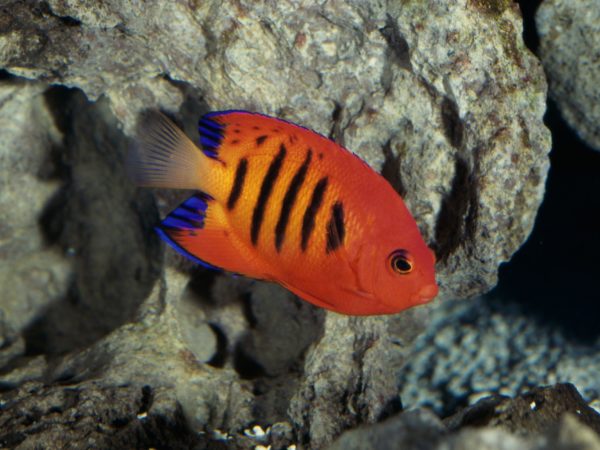
+ Description
The Centropyge loriculus, more often known as the Flame Angelfish, is one of the most popular dwarf angelfish among aquarists of all skill levels. With its bright orange/red hue, vertical black stripes on the body, and blue-tipped fins, it’s the perfect centerpiece for any saltwater reef tank!
+ Reef-compatibility cautions
Flame Angels may be maintained in aquariums alongside invertebrates and corals; however, they have been known to nibble on zoanthids, LPS corals, tridacnid clam mantles, and soft corals on occasion.
- Minimum tank size: 30 gallons
- Mature size: About 4 inches
- Care difficulty: Moderate
- Diet: Omnivore
Flameback Angelfish – least likely
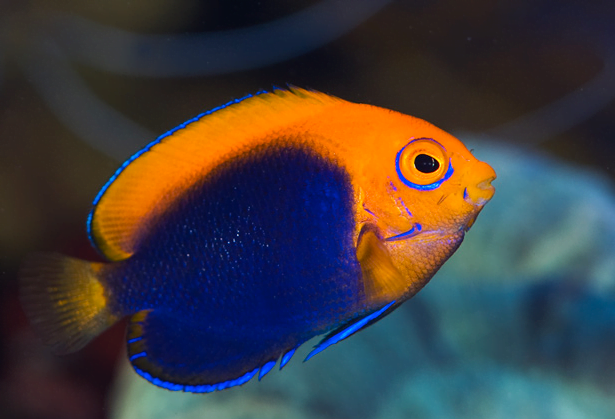
+ Description
The Flameback Angelfish, also known as the African Pygmy Angelfish, is distinguished by its brilliant color contrasts of orange-yellow and blue. The body is blue, but there is a large orange-yellow patch that runs from the head down the back.
+ Reef-compatibility cautions
Although this species is among those that are best suited for a reef tank aquarium, caution has to be taken when introducing it to meaty brain corals (such as Trachyphyllia or Cynarina).
- Minimum tank size: 24 gallon
- Mature size: Up to 3 inches
- Care difficulty: Beginner
- Diet: Omnivore
Collin’s Pygmy Angel – likely
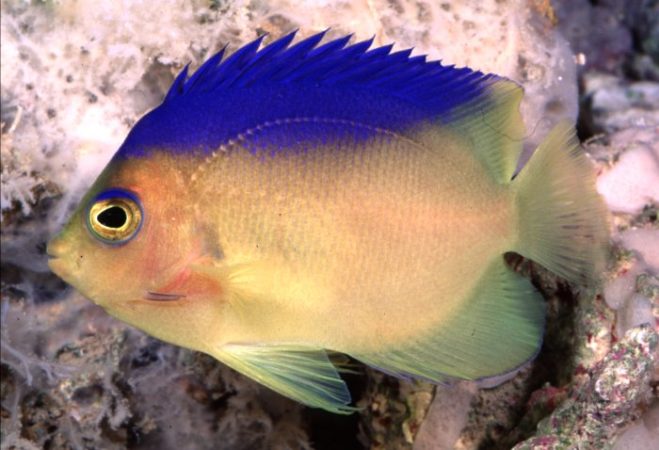
+ Description
Colin’s Pygmy Angelfish has a typical dwarf angelfish shape with a small elongated oval body and rounded fins. The top quarter of this angelfish’s body is blue, while the bottom quarter is yellow. The caudal, anal, and pelvic fins are all yellow, with a blue ring around the eye. Spiny parts of the dorsal fin are blue, whereas the posterior portion is yellow. And their pectoral fins are yellowish.
+ Reef-compatibility cautions
This dwarf angel is only suitable for fish-only community aquariums, and reef environments should only be approached with extreme care. Despite its reputation as a reef-safe fish, it may harm certain types of hard and soft corals if kept in a tank with plenty of coral and sessile invertebrates. It’s unlikely that every fish would harm corals, but the behavior of every fish is going to be different. A reef tank may not be the best place for this fish if you see it picking closely at the corals for an extended period of time.
- Minimum tank size: 30 gallons
- Mature size: 3.5 inches
- Care Difficulty: Advanced
- Diet: Omnivore
Golden Angelfish – likely
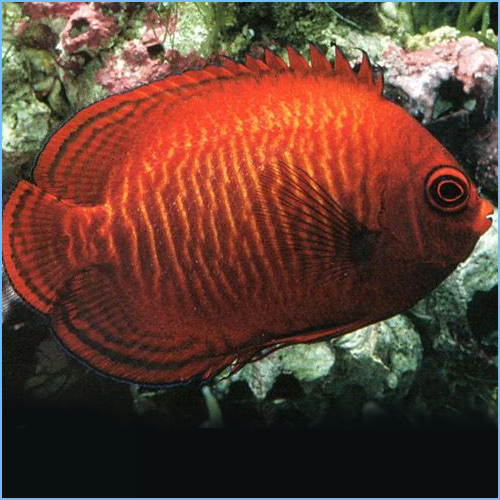
+ Description
The Golden Angelfish has a typical dwarf angel shape. This fish is a small, elongated oval in shape, though it has a fairly deep body and rounded fins.
This dwarf angelfish’s body has a uniform orange to brownish orange color, and it has a number of vertical stripes that are a contrasting yellow, orange, or burned red. The color of the stripes and the main body is the same. Occasionally, the face and head seem darker. The stripes on the dorsal, anal, and tail fin are the same as those on the body, except they run parallel to the body rather than vertically. The pectoral and pelvic fins are solid, and, typically, these forms of fins are darker in color than other parts of the body, or sometimes they can be clearish in color, depending on the specimen.
+ Reef-compatibility cautions
This dwarf angelfish may be maintained in either a fish-only aquarium or, on occasion, a reef environment. Aquarists have generally found little concern about corals being eaten once prepared foods are accepted by the fish. However, Polyps on stony corals may or may not be damaged depending on the nibbling habits of the fish. Therefore, keep a careful check on your fish after adding a new coral to observe how it affects them.
- Minimum tank size: 30 gallons
- Mature size: 3.9 inches
- Care difficulty: Advanced
- Diet: Omnivore
Lemon peel Angelfish – most likely
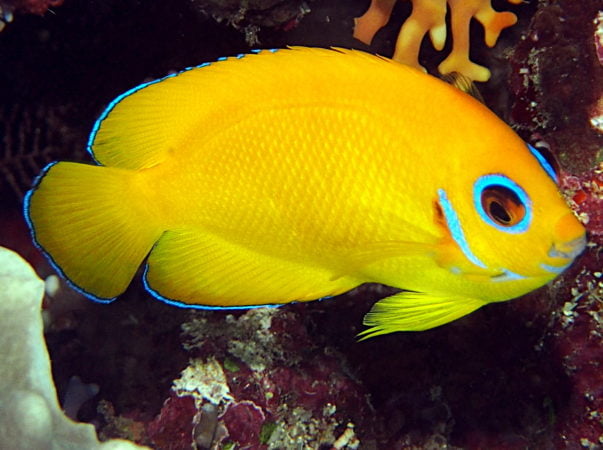
+ Description
The Lemon peel Angelfish is a stunning dwarf angelfish with a striking color pattern that grabs all the attention in the reef aquarium. This fish displays a bright yellow body with sky-blue highlights on its fins and eyes.
+ Reef-compatibility cautions
Solitary and aggressive, the Lemon-peel Angelfish prefers to live alone. When you put two men in the same tank, they will battle until one of them is killed.
Because this species has a tendency to nibble on tridacnid clam mantles, LPS corals, and zoas, you cannot put all of your trust in it when those other invertebrates are present in the tank.
- Minimum tank size: 30 gallons
- Mature size: Up to 5.5 inches
- Care difficulty: Intermediate
- Diet: Omnivore
Bicolor Angelfish – most likely
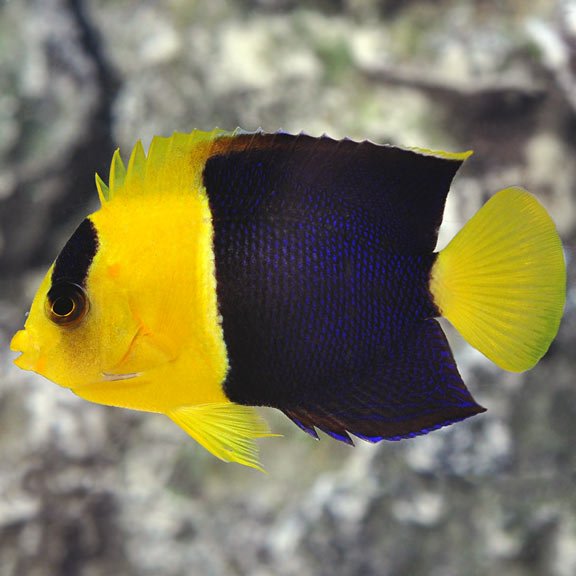
+ Description
As compared to other dwarf angelfish, the Bicolor Angelfish has a slightly longer oval body shape. These tiny angelfish are among the largest of their kind. They are widely known as the two-colored Angelfish because the front one-third to one-half of their bodies are yellow to gold, while the rear two-thirds to three-quarters of their bodies are dark to royal blue. Over the forehead to the top of each eye, there is a blue “mask.” Sometimes, the yellow on this fish’s face seems more “dusky.” Pectoral, pelvic, and tail fins of the fish are yellow, while the dorsal and anal fins are blue and come to a point at their ends.
+ Reef-compatibility cautions
Even though it is one of the most well-known species of dwarf angelfish, the Bicolor Angelfish is not always an excellent choice for a reef aquarium. They are the least reef-friendly of all the dwarf angelfish. If you want to have a healthy reef, you should avoid the Bicolor Angelfish. It is known to nibble at soft corals (sessile invertebrates) and clam mantles.
- Minimum tank size: 55 gallons
- Mature size: 5.9 inches
- Care difficulty: Intermediate
- Diet: Omnivore
Video: Four dwarf angelfishes in Red Sea Reefer 425 reef tank
FAQs
Is it possible for angelfish to live on coral reefs?
They spend much of their time on coral reefs. The majority of species are only found in water that is less than 20 meters deep. Saltwater angelfish seldom dwell below 50 meters. Many species of angelfish have diets adapted to this sort of environment since most feed coral, algae, and invertebrates prevalent on tropical coral reefs.
Which corals are safe for the dwarf angelfish?
The bright orange/red hue, vertical black stripes on the body, and blue-tipped fins make it a stunning centerpiece for any saltwater reef aquarium. Flame Angels is an example. They may be housed in aquariums with both invertebrates and corals. Nevertheless, they have been known to nibble on LPS corals, tridacnid clam mantles, zoanthids, and soft corals on occasion.
Are dwarf angels reef safe?
Are dwarf angelfish reef safe? The answer is both yes and no. Dwarf angels, in general, may be maintained in reef aquariums with no issues. However, in terms of both foraging and shelter, a tank filled with live rock is ideal.

Annette M. Chaney is an experienced marine biologist with over 20 years of experience as an aquarist and fishkeeper. She started her first aquarium at a young age, filling it with frogs and goldfish obtained from the ten-cent pet store.
Annette grew up caring for and breeding African Cichlids, which led to a hobby in high school that doubled as a profitable means. Attending Reed College gave her time to solidify herself as an accomplished aquarium caretaker with an eye for sales. After that, from 2009 – 2013, she studied at Roger Williams University – one of the most prestigious universities for Aquaculture and Aquarium in USA. She is the founder of AquariumCircle since 2010.
